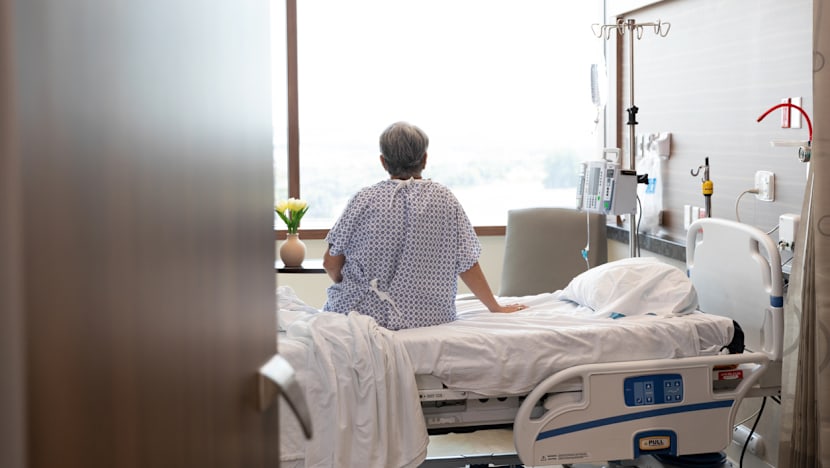Commentary: A long life means little if we’re too sick to enjoy it
Many people are focused on how long they live, but the real prize is in how well they live, say public health experts Dr Daniel Mahadzir and Dr Vandana Garg.

File photo. On average, many Singaporeans suffer up to 10 years of poor health before they die. (Photo: iStock/SDI Productions)

This audio is generated by an AI tool.
SINGAPORE: Singapore residents are living longer than almost anyone else in the world. On average, 81.2 years for men and 85.6 years for women. But life in good health? Not necessarily.
According to the Ministry of Health, only about 75 of those years are spent in good health. That means many Singaporeans suffer up to 10 years of poor health before dying, battling frailty, chronic disease or disability.
Much of the public conversation around ageing focuses on cost. We hear about the need for more hospitals, nursing homes and long-term care facilities.
For 2025, the government has budgeted around S$20.9 billion for healthcare, second only to defence. That figure is expected to hit S$30 billion by 2030.
Families feel the burden too. Many working adults juggle the “sandwich” role of caring for both ageing parents and young children, often at the expense of their own productivity and financial stability.
THE SILVER DIVIDEND
But the story doesn’t have to be one of burden. Economists are increasingly recognising that keeping people healthy costs far less than trying to restore health once it is lost. They point to a “silver dividend”, the productivity and growth gains societies can unlock if older people remain healthier for longer.
The Asian Development Bank estimates that better use of older people’s work capacity could boost gross domestic product across the region by nearly 1 per cent. This may sound modest, but for economies worth trillions, the stakes are enormous.
Don’t get us wrong, this is not an argument for working into one's 80s. Retirement is a well-earned time to rest and enjoy life. But extending the period of health before decline has many benefits for the economy and society.
When older adults stay out of hospitals and nursing homes, it reduces costs for families and governments alike which can be spent on more acute and emergency treatments such as during disasters or unexpected pandemics. Besides, when adult children are not forced to drop out of the workforce to care for sick parents, the entire economy benefits.
Realising such benefits requires inclusive health strategies. What does this mean? The Health Inclusivity Index (HII), developed by Economist Impact with support from Haleon, offers some insight. In a study of 40 countries, it found that annual healthcare costs are nearly three times higher for individuals with low health literacy due to greater use of emergency care and other healthcare services. Reducing the proportion of people with low health literacy by 25 per cent could save US$303 billion a year and boost GDP by 0.4 per cent.
The study also highlighted how worldwide, women have a higher prevalence of musculoskeletal conditions than men, costing economies US$120 billion in healthcare costs and reduced productivity each year. Better prevention could help women to remain healthy and stay in the workforce for longer, the report said.
THE LONGEVITY DIVIDEND
So, what happens if Singaporeans gain just one extra year of healthy life? A conservative back-of-the-envelope estimate suggests the benefits can come in two ways, preserved productivity and healthcare expenditure savings.
Around US$1.5 billion in extra productivity could be achieved as healthier older adults remain active contributors to the economy, whether through formal work, entrepreneurship or community roles. On top of that, US$1.2 billion to US$2.4 billion in healthcare expenditure savings could be realised each year by reducing hospitalisations, long-term care needs and chronic disease management costs. Combined, that’s about US$2.7 billion annually, or roughly S$3.3 billion.
To put it another way, a one-year healthspan gain could be worth 0.5 per cent to 0.7 per cent of Singapore’s GDP. That’s about the size of a mid-tier industry, achieved not by building factories or data centres, but by keeping people healthier for longer.
This economic framing matters because it changes how we think about ageing.
Too often, ageing is treated as a fiscal burden. But if the focus shifts from simply adding years to life toward adding healthy ones, the story changes. Healthspan becomes the foundation of what scholars call the “longevity dividend”, the trillions in economic value that could be realised if we slow down the onset of chronic disease and extend healthy years across the population.
In the United States, modelling studies show that even a modest 2.2-year delay in ageing could generate US$7 trillion in savings over 50 years. Scale that logic to Asia, with its massive and fast-ageing populations, and the dividend could match up with the productivity booms of past technological revolutions.
HOW DO WE BUY HEALTH?
How do we actually buy this extra year of healthspan? The science is clear: Nutrition, physical activity, preventive care and tackling social factors that shape up health are the low-hanging fruits.
These are the simple, evidence-based approaches that can turn longer lives into better ones. In fact, one study led by researchers from NUS’ Saw Swee Hock School of Public Health shows that sustained lifestyle changes could save S$650 million in healthcare costs by 2050.
Prevention, in other words, is not just good for individuals but for the economy as well.
In Singapore, two areas warrant closer attention in shaping long-term public health outcomes. The first is to shift the focus from treatment to prevention.
Our primary care clinics and polyclinics are well-positioned to support this by working with the Health Promotion Board to offer more engaging and interactive initiatives to encourage regular screening and support individuals in making better lifestyle choices. Health promotion efforts may also benefit from stronger support within workplaces and schools.
Beyond clinical settings, community centres and hawker centres can also play an important role. These familiar public spaces could be transformed into neighbourhood wellness hubs for residents to access community-based activities, exercise programmes and healthier food offerings. Hawkers, in particular, could benefit from nutritional training and financial incentives to offer healthier food options.
Asia is ageing at warp speed. By 2050, one in four people in the region will be over 60. That trajectory cannot be reversed. What can be changed is how those years are lived and whether they are seen as an economic liability or an asset.
Singapore, with its world-class healthcare system and reputation for forward-thinking policy, has an opportunity to lead. Just as it turned limited land into a food security story and scarce water into a sustainability triumph, it could turn ageing into a health preservation story, one that unlocks billions in economic value while giving its people more life in their years.
The question isn’t whether we can afford to invest in healthspan. Rather, can we afford not to?
Daniel Mahadzir is Innovation Fellow, SingHealth Duke-NUS Global Health Institute. Vandana Garg is Medical & Scientific Affairs Director (Southeast Asia and Taiwan) at Haleon.






















